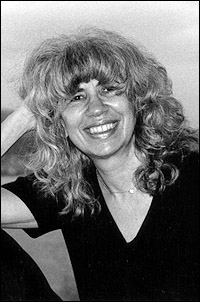
*
If the lines "I carried a watermelon" and "Nobody puts Baby in a corner" are as familiar to you as your name, it's a good bet that you're passionate about the 1987 movie Dirty Dancing. Its fans are legion. Dirty Dancing was the first movie to sell a million copies on video. A 2007 poll taken in Great Britain found that it was the most-watched film by women, and it's a good bet that if a poll were taken in this country, the results would be similar. So the idea of adapting this beloved movie for the theatre probably seems to be a no-brainer.
But Eleanor Bergstein, the screenwriter, co-producer and driving force behind the film, resisted bringing the piece to the stage for almost 20 years. "Six months after the movie opened, I had all kinds of offers," she says. "But I had no desire to slap a movie onstage. We have such open-hearted people who watch the movie over and over again, and I never wanted to seem to be taking advantage of them. I also thought that turning it into a piece of regular musical theatre would be totally wrong and unnecessary. So I just said no for years."
She began to change her mind when she learned what happened when local television stations ran the movie in a loop — meaning they'd run it continuously, all day. Marketing surveys found that people watched the movie again and again. For Bergstein, that was an epiphany. "Even if they had the video at home, they watched," she says. "It seemed to me that what they really wanted to do was to step through the flat screen and experience the kinetic sense of being there. And I realized you can get that with live theatre."
Which is why Dirty Dancing is now touring the country prior to an anticipated Broadway engagement. The show is already an international hit. It originated in Australia in 2004 and has had, or continues to have, successful runs in London, Toronto, Holland and Germany. For anyone unfamiliar with the movie, Dirty Dancing is the coming-of-age tale of 17-year-old Frances "Baby" Houseman, the brainy, idealistic daughter of a doctor. It's the summer of 1963, and Baby and her family are vacationing at a resort in the Catskills. She becomes infatuated with the streetwise, blue-collar dance instructor, Johnny Castle, much to her father's disapproval. Despite the obstacles, Johnny teaches her to "dirty dance," they fall in love and change each other's lives.
 |
||
| Eleanor Bergstein |
The same is true of Kate Champion's choreography. "Kate believes in the choreography of everyday life, that every movement has a meaning. We have no unison dancing. Everyone has their own individual movements that connect them to the physical world. The choreography is very beautiful, but we wanted everyone watching to feel that if their heart were high enough, they could be doing the dancing."
Dance has always been integral to Bergstein's life, and Dirty Dancing is inspired by her own experiences. Bergstein was called Baby until she was 22, she has a sister named Fran, and her father was a doctor. Baby Houseman plans to join the Peace Corps. Baby Bergstein "wanted to change the world, but in a matched sweater set." The family lived in Brooklyn and summered in the Catskills. "My parents hit the golf course and I went to the dance studio," she says. "I was a teenage mambo queen. But I was also the dirty dancing queen. I grew up in a very rough neighborhood and spent my time in basements, where we dirty danced — it was street dancing to rhythm-and-blues music. I have trophies that would turn your hands green. Later I was an Arthur Murray teacher. There's really a lot of Johnny in me, as much as Baby."
The screen family, like the Bergsteins, are Jewish, left-wing liberals, and the piece was very deliberately set in 1963. "It was a time when people believed that they could put out their hands and make the world better," says Bergstein. "It was the summer of Martin Luther King's 'I Have a Dream' speech. There was a kind of grace about that time. And that was the last summer. A few months later, J.F.K. was assassinated, and it was all over. After that, it was radical action every place."
Bergstein says that over the years, she has thought about why the movie — and now the show — has earned such ardent devotion. "My feeling right now is that everyone has a secret dancer inside them," she says, "and the show is about how dancing can connect you to the world."










